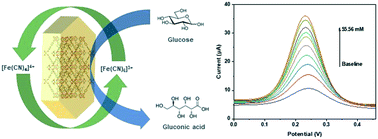Hydrogen-bonding 2D coordination polymer for enzyme-free electrochemical glucose sensing†
Abstract
Regular detection of blood glucose levels is a critical indicator for effective diabetes management. Owing to the intrinsic highly sensitive nature of enzymes, the performance of enzymatic glucose sensors is typically impacted by unwanted dependencies on pH, temperature and humidity. Correspondingly, the development of robust enzyme-free glucose sensors is desired due to their potential to improve upon the operational flexibility of traditional systems. In this study, a new coordination polymer (CP) incorporating melamine (Mel), biphenyl-4,4′-dicarboxylate (BPDC2−) co-ligands and Zn(II) metal nodes, [Zn2(BPDC)1Mel0.5–Mel0.5]·(DMF0.6) {denoted CP1}, was synthesised and characterized for non-enzymatic glucose sensing. Here, the 2D layers are connected by hydrogen bond (H-bond) interactions between the interstitial melamine molecules. In addition to conventional characterization methods, we also used density functional theory (DFT) calculations and variable temperature Raman spectroscopy to computationally and experimentally explore the H-bond interactions in CP1. CP1 was deposited onto a glassy carbon (GC) electrode to facilitate its incorporation into an electrochemical sensing device. When used as an electrochemical glucose sensor, the CP1/GC electrode exhibited accurate clinical performance characteristics, with a wide linear sensing range extending from 5.6 μM to 5.56 mM (R2 = 0.9852) and with a high sensitivity of 517.36 μA mM−1 cm−2. Low sample loadings are a further important advantage associated with this CP-based non-enzymatic glucose sensor.



 Please wait while we load your content...
Please wait while we load your content...